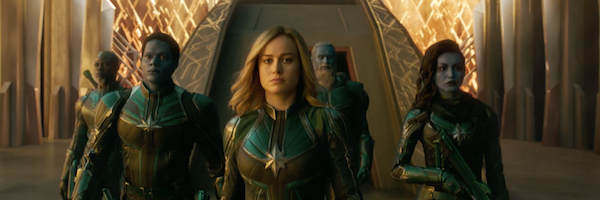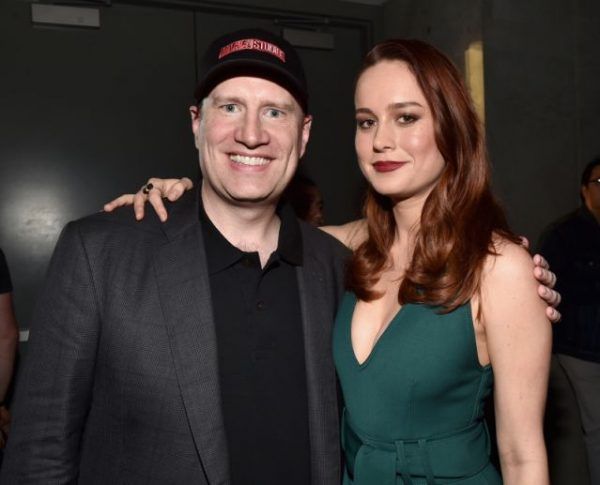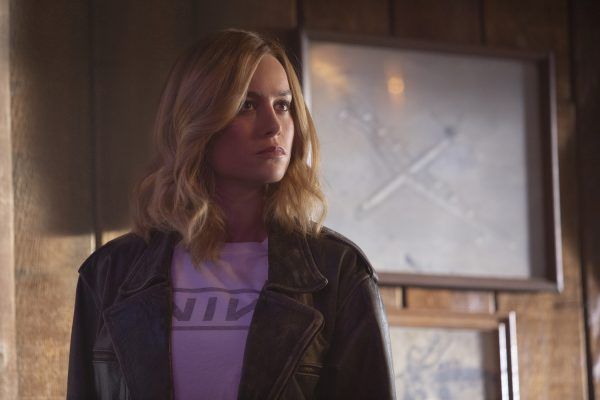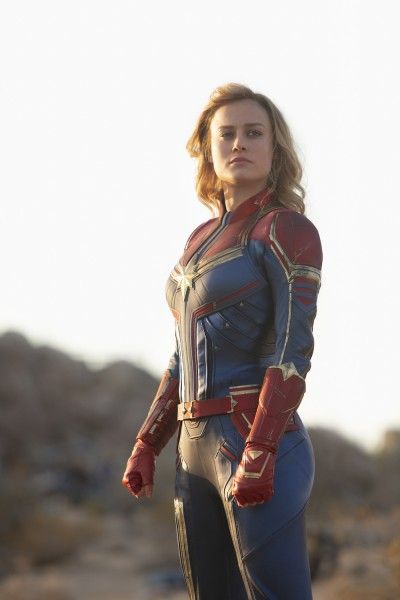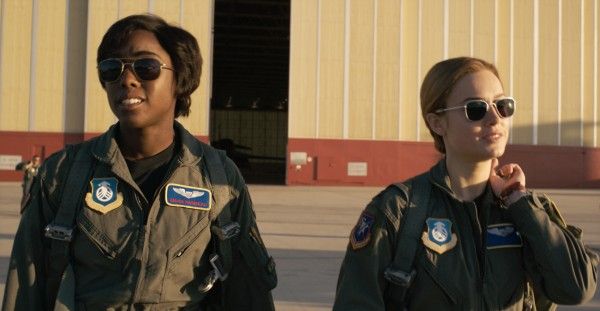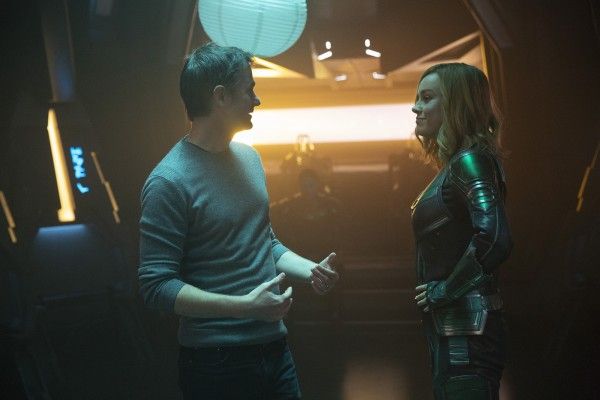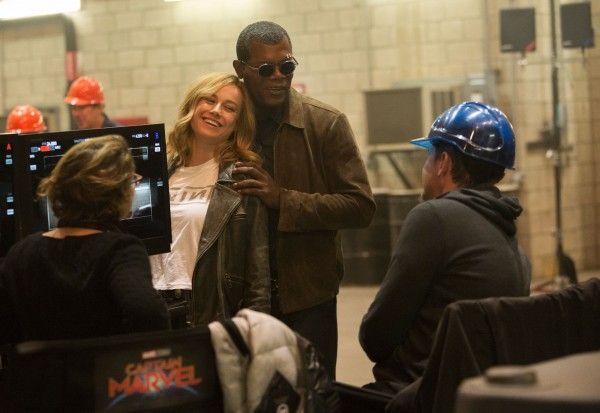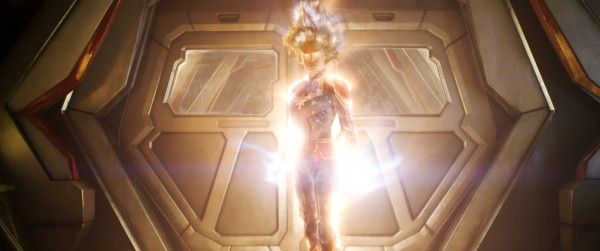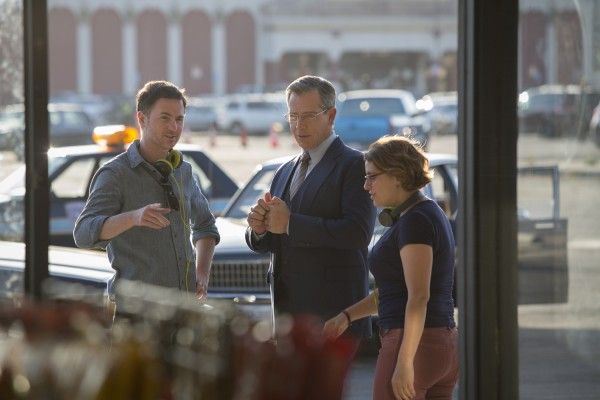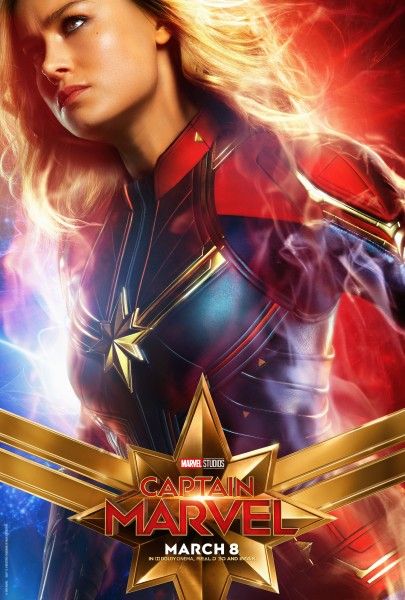From filmmakers Anna Boden and Ryan Fleck, the latest adventure from Marvel Studios is Captain Marvel, set in the 1990s and following the journey of self-discovery that shapes Carol Danvers (Brie Larson) into one of the universe’s most powerful heroes. While Danvers is on a personal mission to recover the missing memories of her past, a galactic war between the Kree and the Skrulls reaches Earth.
At a conference held during the film’s Los Angeles press junket, co-stars Brie Larson (“Captain Marvel”), Samuel L. Jackson (“Nick Fury”) and Lashana Lynch (“Maria Rambeau”), along with writer/directors Anna Boden and Ryan Fleck and Marvel Studios President Kevin Feige, talked about bringing Carol Danvers to life, altering the Marvel filmmaking process to fit the story and the vision of the directors, going through a physical transformation to play the strongest being in the galaxy, how Carol and Maria became friends, military training, ‘90s nostalgia, the de-aging process, working with a live cat, and what they’ll personally take away from this project.
Question: Kevin, what did co-directors Anna Boden and Ryan Fleck say about Captain Marvel, in your first meeting with them, that sold you on them for this film?
KEVIN FEIGE: Well, it was more than one meeting. There were a number of meetings. It was their body of work and their focus on character, and our belief that they wouldn’t lose the character amongst the spectacle, the fun, and the effects. Anna spoke very eloquently about Carol Danvers. Over the course of developing and producing the movie, Anna went up in a jet, as did Brie [Larson], which was super impressive, and I wouldn’t do it for a million dollars. It was astounding. So, in those early meetings and through their amazing body of work, they made us realize that they could bring Carol to life.
Ryan and Anna, how did you guys adjust to making a film of this size?
RYAN FLECK: In the early conversations with Kevin and Brie, we wanted to make sure to bring an intimacy and character-focused storytelling. The visual effects were challenging for us, at first, but we were working with the best in the business. They’ve done one or two of these movies before, so we knew that we were in good hands. We were able to lean on them and work very collaboratively with the effects team to learn about how that works. They were patient with us, and it was wonderful. I can’t think of a better studio to take that leap with. Marvel are the best collaborators, and they really let us tell the story we wanted to tell.
FEIGE: In terms of the visual effects, (producer) Victoria Alonso, who’s been with us since the beginning and who knows this stuff, inside and out, and is an amazing mentor to filmmakers, and Christopher Townsend, who’s done many movies for us, was our visual effects supervisor. Because this was ultimately always about the story, there’s nobody pushing the process to overwhelm the story. We’ll alter the process to fit the story and the director’s vision. That’s how you end up with a great movie like this.
Brie, Carol Danvers is not your average damsel in distress. She’s a woman who’s got edges to her and a little bit of a dark side. Why do you love this Captain Marvel?
BRIE LARSON: There’s a lot to love about her, which is why I was really excited to do this. It was the idea of playing a superhero, or a female superhero, in particular, ‘cause my interest is in female complexity. I was a little worried about playing a superhero that would be perfect ‘cause I don’t feel like that’s realistic, or something aspirational, at all. Even with my job, you see this beautiful finished product, where I look great, but you don’t know all of the other takes that are on the cutting room floor, when I physically landed on my face doing stunts, or I just did a bad take. That’s just how it goes. So, getting to play a character where the whole character arc and turn of this is watching her be this major risk-taker, which means it’s not always going to work out for the best. And those are the moments, the defining moments of her character, where she doesn’t lay down, she gets back up. That’s everything. That’s for everybody. There isn’t a person who can’t relate to that, I don’t think.
In the process of the physical transformation you made to make Captain Marvel look like the strongest being in the galaxy, was there ever that day where you just wanted to give up?
LARSON: Yeah, all the time. When you’ve been training for that many hours, every day for nine months, I sobbed in the gym, many times. My trainer would be like, “Oh, she’s crying again.” It’s very emotional, when you’re stirring up something very vulnerable and raw inside of you. You also learned that it’s just for you. There was nothing for me to prove. I wasn’t proving it to other people at the gym. I certainly wasn’t proving it to my trainer because he was never going to be fully impressed. It’s his job to not be impressed. So, it was for myself. And the main reason for doing it was so that, in moments like this when we’re talking about Carol’s strength and what I learned from her, it’s that I’m stronger than I realized. Of course, this movie is assisted with the visual effects because I can’t personally shoot photon blasts. There’s not enough prep in the world for me to do that yet, but I will figure it out, if there’s a way. But I can say that I’m really strong. I was able to dead-lift 225 pounds, hip-thrust 400 pounds, and push my trainer’s 5,000-pound Jeep up a hill for 60 seconds. When it comes to gender norms, or what the human body is capable of, or what a female body is capable of, it’s capable of a lot.
At what point in your prep work did you feel that you’d found Carol Danvers?
LARSON: Usually, I prep for a really long time, to put myself in the feeling or the experiences of the character, so that I can see how I’d react as her, in a way, but it’s super delayed for me. It’s usually my mom that points it out and says, “I think you’re turning into somebody else.” I’m like, “No, I’m not.” And then, two weeks later, I’m like, “Oh, shoot, I’m Carol now.” It’s always a little delayed for me. It’s not like I have this moment. I know some actors have this moment, where they’re like, “Okay, she’s arrived.” I don’t have that. I think part of it is because I never want to feel like I have it or that I know her. It always feels a little elusive to me, which is how you can keep trying and searching, every day for a year. If you feel like you’ve arrived, then it’s game over. I always like to feel like I’m losing it, a little bit.
Lashana, you campaigned to be in the MCU. How did you make this happen?
LASHANA LYNCH: I was gonna get me in that room. Those were the words that I had in my head, for two years. I’m a Marvel fan. I’ve grown up watching the films, loving the characters and enjoying the trajectories, and I just had a feeling that something would come up. I kept sending in tapes, but they all didn’t work out for a reason. I felt energetically drawn towards this because it represented something that I care about, which is women. So, yeah, I campaigned to be here.
Carol and Maria’s friendship is such a great dynamic. If we were to go back to the beginning of their friendship, what do you think it was that drew them together?
LYNCH: They were both in the military, so they come from male-dominated environments and were drawn towards the women there. They found power in whoever they could have energetic connections to. They had a sarcasm together. Carol is able to be every facet of what a woman represents today. She’s sarcastic, dry and funny, and she can kick throw men into different parts of the universe. I feel like Maria embodies that, in a very human way. She’s able to just be a good person.
LARSON: I think what they’ve gone through, going through military training together and being the only women, and then using each other to lean on each other, is really special. I think they would have been friends outside of that experience, but that’s a really tight-knit bond that they have. They’re family. Without being too showboaty about it, it’s the great love of the movie. It’s love lost, that’s found again. It’s the reason to continue fighting and to go to the ends of the Earth for the person that you love, and it’s her best friend and her best friend’s daughter. To me, that’s so natural. It’s not something that we make a big deal about, but it just feels so natural because that love is so strong. And to brag about Lashana for a second, the movie shifts when she’s onscreen because there’s a level of power that she commands. That’s amazing. You can’t ask for anything more than that.
What sort of military training did you go through for this?
LYNCH: I was able to go through some military training. Flying an F-16 is like having your eyeballs coming out of the sockets and landing in your back pocket. That was great. I can’t liken it to anything else, but that. It’s wonderful to be able to be an actor and just add these different experiences and skills to your repertoire, and it was nice to have the military welcome me into their environment. I feel like I’m not only representing women, but I’m representing black women, I’m representing single mothers, and I’m representing all women in the military, and that’s pretty damn special.
Ryan and Anna, one of the really fun things about the movie is just how many awesome ‘90s touches it has. Was that in the script, from the beginning? Did you have all of those music cues in there, or did that come up in the pre-production process?
FLECK: We made a big playlist, at the beginning of the movie, and we shared it with the crew and some of the cast, and some of those songs are in the movie. But it was really in post, when we put the scenes together, that we threw songs in to see what stuck. It was very much a collaboration with Kevin [Feige] and the whole team at Marvel, to figure out which songs really worked the best. I actually worked at a Blockbuster in 1995, so creating that set brought back a lot of memories.
Was there anything that you wanted to get into the film that you couldn’t?
ANNA BODEN: I was a big candy eater in the ’90s, and there were those Dunkaroos. I liked the chocolate kangaroos with the vanilla icing. But Carol doesn’t eat in the movie enough, so we couldn’t get those in.
Because of all of the ‘90s nostalgia in this film, is there anything from the ’90s that you wish would come back?
FLECK: VHS tapes.
BODEN: Pay phones because then I wouldn’t have to check my email, all the time.
SAMUEL L. JACKSON: Laser discs.
LARSON: He’s very passionate about laser discs, by the way. That’s not a joke. For me, it’s butterfly clips.
LYNCH: R&B. Just R&B because ‘90s R&B was the truth, man. I’m actually gonna start a campaign to bring back ’90s R&B.
FEIGE: Video stores. I miss walking around video stores.
Sam, this is a Nick Fury that we haven’t gotten to see before. What did you like about embodying this ’90s version of our favorite S.H.I.E.L.D. leader?
JACKSON: He’s a kinder, gentler, not so cynical, world-weary, chip-on-his-shoulder Nick Fury, who hasn’t met anyone from another universe, just looking at the crazy lady, trying to figure out why she thinks she’s an alien and what all of that means. It’s fun to not be the all-knowing, angry, persuader that Nick Fury always is. And it was even more refreshing to have two eyes, so I didn’t have to cover one eye while I was learning my lines.
What’s it like to go through the de-aging process?
JACKSON: There’s not a real on set process. They put the wig on me and put dots my face, so it kind of felt like I was in Wakanda. They explored different things that I had done before, so that they could use facial expressions that were already there. Fortunately, they had stuff to refer to, so it was cool. It was just me with dots on my face, having fun with Brie.
FEIGE: The technology is spectacular. We’ve done it in a number of films, and I think this represents the peak. However, the two people that we did it to – Sam Jackson and Clark Gregg – are the two human beings on earth who don’t need it. I urge you to Google them in 1995. It’s almost identical, so we saved a lot of money.
Sam, what was it like to work with the cat?
JACKSON: I am not a cat person, but I’m also not a dog, bird or fish person, either. I don’t engage pets. Reggie is like most animals that people bring to set, that have been trained to do this, that or the other. He’s snack-oriented. If you give him something to eat, he shows up. You give him something to eat, you talk softly and nicely to him, you give him something to eat again, and they love you, so it works out. There were actually four cats, but Reggie did the majority of the heavy lifting. [Brie] had more problems with him than I did because she has cat allergies.
LARSON: I’m severely allergic. It’s wasn’t like he was a diva and we couldn’t work together because he was trying to sabotage me.
JACKSON: We didn’t hang out between shots and carry Reggie around. We gave him back to the people that owned him, let him be in his own space, and sent him back to his trailer.
LARSON: And just to be clear, the other three cats were more like Reggie’s stunt doubles.
JACKSON: And they weren’t so people-friendly, either.
Ryan and Anna, because you guys wrote this, was there ever any temptation to not have to work with a live cat?
BODEN: There’s something about getting a cat to just do what he normally does. That was actually part of the struggle of having a very well-trained, very directable cat. Sometimes we just wanted him to do the random things that a cat will do, like lick his paw, or go rub up against somebody. We sometimes had to suggest to the trainer that maybe we should just let him do his thing for a little while because there’s something about the spontaneity of what an animal can do.
Brie, how do you think this character adds to the conversation about diversity?
LARSON: I’m just doing what I can do, based upon my experience and my one body, which is why representation on screen is so important. No one person can tell the entire story, we can only tell our piece of it. With films like this, that do end up going international, because a lot of the time, with smaller movies, you don’t know if they will or not, it means you get to have a really extensive conversation, and I’m so grateful that this film has so many pockets in it. If you want to just enjoy it, you totally can, but there a lot of aspects to it that I think are worth talking with your friends and family about. When you have a multi-cultural, global conversation like that, it allows all of us, through the veil of metaphor of a film, to be able to reveal some deeper truths and maybe empathize, in a new way.
What was the biggest lesson or takeaway you got from being a part of this project?
LYNCH: Mine was my forever appreciation for single mothers, who don’t get enough light shone on them, ever. To be able to have that opportunity to represent them and say, “I’d like to send a universal thank you for your work,” was actually really special. I went to my mum, and other mums that I know, and was like, “I just wanna say thanks for everything that you’ve done for the last however many years.” It really goes a long way, just to say thank you, daily. That’s what I’ve taken away.
LARSON: I learned that I’m stronger than I realized, which is crazy because I knew that I was really strong.
BODEN: Over the course of making this movie, I realized that, as a person, I’m more comfortable hiding and not being seen. When Ryan and I made our first short film together and were at Sundance, we won an award and, when we got on stage, I literally hid behind him. It’s on tape somewhere. This whole process has helped me be more confident in my voice and just be a little bit more comfortable being seen.
FLECK: I’ve always known this, but I learned just how kick-ass my directing partner is. She’s awesome!
FEIGE: It’s about meeting new people, seeing people grow and evolve, and bringing an unbelievably powerful female character to the screen.
Captain Marvel opens in theaters on March 8th.

